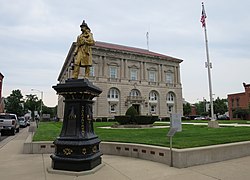Demographics
Historical population| Census | Pop. | Note | %± |
|---|
| 1830 | 230 | | — |
|---|
| 1840 | 5,189 | | 2,156.1% |
|---|
| 1850 | 7,221 | | 39.2% |
|---|
| 1860 | 12,808 | | 77.4% |
|---|
| 1870 | 17,081 | | 33.4% |
|---|
| 1880 | 23,713 | | 38.8% |
|---|
| 1890 | 30,188 | | 27.3% |
|---|
| 1900 | 32,525 | | 7.7% |
|---|
| 1910 | 29,972 | | −7.8% |
|---|
| 1920 | 27,751 | | −7.4% |
|---|
| 1930 | 25,074 | | −9.6% |
|---|
| 1940 | 25,016 | | −0.2% |
|---|
| 1950 | 25,248 | | 0.9% |
|---|
| 1960 | 28,331 | | 12.2% |
|---|
| 1970 | 31,134 | | 9.9% |
|---|
| 1980 | 32,991 | | 6.0% |
|---|
| 1990 | 33,819 | | 2.5% |
|---|
| 2000 | 34,726 | | 2.7% |
|---|
| 2010 | 34,499 | | −0.7% |
|---|
| 2020 | 34,451 | | −0.1% |
|---|
|
2000 census
As of the census [10] of 2000, there were 34,726 people, 12,200 households, and 9,308 families living in the county. The population density was 72 people per square mile (28 people/km2). There were 12,753 housing units at an average density of 26 per square mile (10/km2). The racial makeup of the county was 96.26% White, 0.17% Black or African American, 0.15% Native American, 0.18% Asian, 0.01% Pacific Islander, 2.51% from other races, and 0.73% from two or more races. 4.38% of the population were Hispanic or Latino of any race.
There were 12,200 households, out of which 39.20% had children under the age of 18 living with them, 64.90% were married couples living together, 7.40% had a female householder with no husband present, and 23.70% were non-families. 21.30% of all households were made up of individuals, and 10.50% had someone living alone who was 65 years of age or older. The average household size was 2.81 and the average family size was 3.29.
In the county, the population was spread out, with 29.70% under the age of 18, 8.30% from 18 to 24, 28.10% from 25 to 44, 20.60% from 45 to 64, and 13.30% who were 65 years of age or older. The median age was 35 years. For every 100 females there were 98.50 males. For every 100 females age 18 and over, there were 97.00 males.
The median income for a household in the county was $46,426, and the median income for a family was $52,859. Males had a median income of $36,548 versus $23,963 for females. The per capita income for the county was $18,680. About 4.00% of families and 5.60% of the population were below the poverty line, including 6.40% of those under age 18 and 9.80% of those age 65 or over.
2010 census
As of the 2010 United States Census, there were 34,499 people, 12,872 households, and 9,556 families living in the county. [11] The population density was 71.5 inhabitants per square mile (27.6/km2). There were 13,731 housing units at an average density of 28.5 per square mile (11.0/km2). [12] The racial makeup of the county was 95.7% white, 0.3% black or African American, 0.2% Asian, 0.2% American Indian, 2.7% from other races, and 0.9% from two or more races. Those of Hispanic or Latino origin made up 5.5% of the population. [11] In terms of ancestry, 65.6% identified as German, 7.8% were Irish, 7.3% were American, 4.7% were English, 2.4% were French, 1.8% were Swiss, 1.7% were Dutch, 1.6% were Italian, 1.4% were Scottish, 1.0% were Welsh, 0.8% were Hungarian and 0.8% were Polish. [13]
Of the 12,872 households, 35.0% had children under the age of 18 living with them, 62.9% were married couples living together, 7.4% had a female householder with no husband present, 25.8% were non-families, and 22.5% of all households were made up of individuals. The average household size was 2.66 and the average family size was 3.13. The median age was 39.0 years. [11]
The median income for a household in the county was $56,573 and the median income for a family was $65,882. Males had a median income of $44,417 versus $33,200 for females. The per capita income for the county was $24,023. About 5.8% of families and 7.1% of the population were below the poverty line, including 9.8% of those under age 18 and 7.0% of those age 65 or over. [14]

Ross County is a county in the Appalachian region of the U.S. state of Ohio. As of the 2020 United States Census, the population was 77,093. Its county seat is Chillicothe, the first and third capital of Ohio. Established on August 20, 1798, the county is named for Federalist Senator James Ross of Pennsylvania. Ross County comprises the Chillicothe, OH Micropolitan Statistical Area, which is also included in the Columbus-Marion-Zanesville, OH Combined Statistical Area.
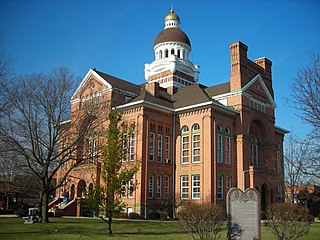
Paulding County is a county located in the U.S. state of Ohio. As of the 2020 census, the population was about 18,806. Its county seat is Paulding. The county was created in 1820 and later organized in 1839. It is named for John Paulding, one of the captors of Major John André in the American Revolutionary War.

Muskingum County is a county located in the U.S. state of Ohio. As of the 2020 census, the population was 86,410. Its county seat is Zanesville. Nearly bisected by the Muskingum River, the county name is based on a Delaware American Indian word translated as "town by the river" or "elk's eye".

Marion County is a county located in the U.S. state of Ohio. As of the 2020 census, the population was 65,359. Its county seat is Marion. The county was created in 1820 and later organized in 1824. It is named for General Francis "The Swamp Fox" Marion, a South Carolinian officer in the Revolutionary War.
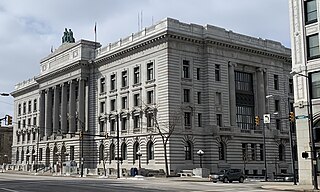
Mahoning County is a county in the U.S. state of Ohio. As of the 2020 census, the population was 228,614. Its county seat and largest city is Youngstown. The county is named after the Mahoning River and was formed on March 1, 1846; the 83rd county in Ohio.
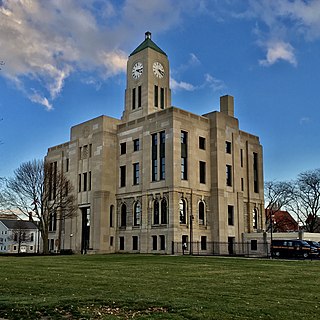
Erie County is a county located in the northern portion of the U.S. state of Ohio. As of the 2020 census, the population was 75,622. Its county seat and largest city is Sandusky. The county is named for the Erie tribe, whose name was their word for "wildcat". It was formed in 1838 from the northern third of Huron County and a portion of Sandusky County.

Darke County is a county in the U.S. state of Ohio. As of the 2020 census, the population was 51,881. Its county seat and largest city is Greenville. The county was created in 1809 and later organized in 1817. It is named for William Darke, an officer in the American Revolutionary War. Darke County comprises the Greenville, OH Micropolitan Statistical Area, which is also included in the Dayton-Springfield-Sidney, OH Combined Statistical Area.

Leipsic is a town in Kent County, Delaware, United States. It is part of the Dover, Delaware Metropolitan Statistical Area. The population was 178 in 2020.

Fort Jennings is a village in the southwestern corner of Putnam County, Ohio, United States. The population was 525 at the 2020 census.
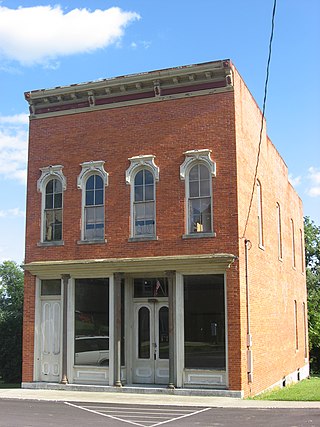
Gilboa is a village in Putnam County, Ohio, United States. The village is named after Mount Gilboa. The population was 168 at the 2020 census.

Glandorf is a village in Putnam County, Ohio, United States. The population was 969 at the 2020 census.

Kalida is a village in Putnam County, Ohio, United States. The population was 1,455 at the 2020 census.

Leipsic is a village in Putnam County, Ohio, United States. The population was 2,177 at the 2020 census.
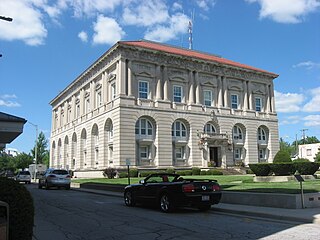
Ottawa is a village and the county seat of Putnam County, Ohio, United States. It is located about 51 miles (82 km) southwest of Toledo. The population is 4,456 as of the 2020 census.

Ottoville is a village in Putnam County, Ohio, in the United States. The population was 966 at the 2020 census.

Pandora is a village in Putnam County, Ohio, United States, located on the Riley Creek. The population was 1,204 at the 2020 census.

West Leipsic is a village in Putnam County, Ohio, United States. The population was 226 at the 2020 census.
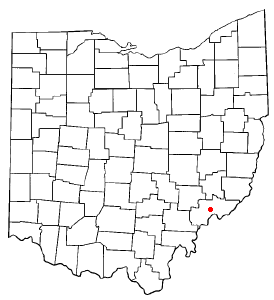
Devola is a census-designated place (CDP) in Washington County, Ohio, United States, along the Muskingum River. It is part of the Parkersburg-Marietta-Vienna, WV-OH Metropolitan Statistical Area. The population was 2,639 at the 2020 census.
Ottawa – Glandorf Local School District, is headquartered in eastern Putnam County, Ohio in the United States. The district serves students from the villages of Glandorf and Ottawa as well as parts of Blanchard, Greensburg, Liberty, Pleasant and Union Townships and all of Ottawa Township.

Ottawa County is a county located in the northwestern part of the U.S. state of Ohio. As of the 2020 census, the population was 40,364. Its county seat is Port Clinton. The county is named either for the Ottawa (Odawa) Indigenous peoples who lived there, or for an Indigenous word meaning "trader".
